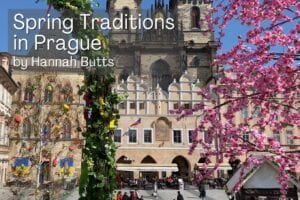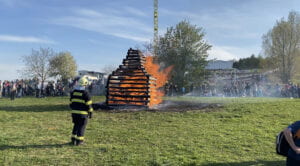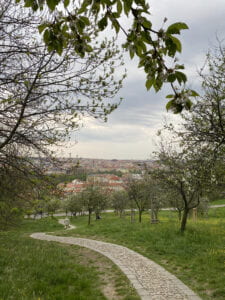
By Hannah Butts
Spring is an absolutely beautiful time to be in Prague. Flowers start blooming in the grass and in the trees along the street, the sun comes out and the lines for ice cream at Crème de la Crème extend down the sidewalk.
In the springtime, the Czechs also have some traditions that are totally new to an American. I was invited by a Czech local to accompany her and her two young sons to a Witch’s Night Festival on the last weekend of April. I was told there would be bonfires, sausages, costumes and rides. It sounded fun to me, so I agreed to take the 40 minute bus ride to Prague 8 and see what this was all about.
When I arrived, the first thing we did was rush to see the burning of the witch. I knew to expect a bonfire, but what I saw was not something I would not have felt safe gathering around to sing campfire songs.
Instead, it was a massive tower of logs, stacked neatly on one another probably 15 feet high, set ablaze by firemen who made sure the crowd remained a safe distance away. At the very top, there was a small scarecrow-looking figure, who was wearing a black cape and pointy witch’s hat. Before I knew it, that poor witch would be gobbled up by the raging fire.
My interest was piqued, and I asked my host what this was all about. She wasn’t really sure, she just knew her kids enjoyed the carnival rides and live music each year, but directed me to her husband who might know more. He informed me that this celebration is called Čarodějnice in Czech. The tradition of burning a witch in the fire stems from an old superstition that at the end of April, witches would gather on high mountains, and in order to drive them away, people built smoky fires along the hill. Overtime, this morphed into what is today the witches celebration, where the large fire is used to symbolize chasing away the spirits of Winter and welcoming in the Spring.
Even though the tradition is based on an old superstition, it seemed to be working, as the sun was now setting over a beautiful Spring evening. Soon, when the fire had calmed down a little, the firemen split up the logs into smaller, more manageable bonfires that were spread all across the field. The family I was with pulled sausages out of their bag, and we all enjoyed roasting some juicy meat as we talked about the beauty of Spring.

The day after Čarodějnice is also a holiday celebrated in Prague. Called May day, the 1st of May is officially commemorated as Labor Day and it is recognized by many European countries. This holiday is meant to honor the struggles and gains made by workers throughout history, although nowadays in Prague the holiday has shifted to a time when love and romance is the main focus.
One of the biggest traditions on this day in Prague is to kiss a loved one under the cherry blossoms. It is said that by doing this, one can bring about luck to the relationship.
My friends and I all enjoyed heading to the beautiful Petrřín Gardens on May Day to see the rows and rows of white and pink cherry blossoms lining the steep hill which overlooks the city. It certainly was a romantic place, and we were surrounded by couples taking in the beautiful view, and enjoying one another’s company.

Perhaps the Spring tradition that is the most foreign to Americans is the Easter day celebration in Prague. Despite being a very atheist city, Easter is a huge holiday here. In preparation for the day, the Easter markets all around town sell large woven branches with colorful ribbons on top. As a tourist, I thought this was just another vibrant Easter decoration, like the painted eggs or fluffy imitations of chicks and bunnies. However, after speaking to some Czech locals I discovered I was grossly mistaken.
The woven branches are actually sticks from willow trees, and it is customary that on Easter, men hit women with the branches in order to bring them beauty and fertility. In return for being beaten, the women give a gift to the men of eggs or chocolate. This sexist tradition is something that would almost certainly raise protest in New York, so I set out to find out more about how it is perceived by Czechs.
I discovered in talking to people of varying ages that there is a huge generational divide in the way people think about this tradition. By and large, the older generation thinks of the practice as great fun, and when asked if they think it’s problematic that women get hit, the common response was “oh, it’s tradition!” which in their minds, is a justification.
However, the Czech high-schoolers I talked to who were ages 16-19 said they absolutely hate this tradition. One girl told me the story of how one year, her uncle got very drunk on Easter and by the end of the night he was hitting her so hard that she woke up with bruises the next day. Now, she says she hides in her room for as long as possible on Easter, to avoid her brother and the other men in her family.
After hearing this, I feared for my life on Easter day. I was assured however, that this tradition was practiced much more strongly in the surrounding villages of Prague, so it was unlikely that I would have to deal with any male strangers violating my personal space with a willow stick as I walked around the city center.
This brought me some comfort, although I still can’t help but feel bad for the girls along the countryside that are involuntarily getting beaten just because it’s what has been done on Easter historically. The tradition is very popular now, but maybe as the next generation grows up, we will see it morph into something less physically abusive, and more focused on allowing all genders to enjoy the day.

